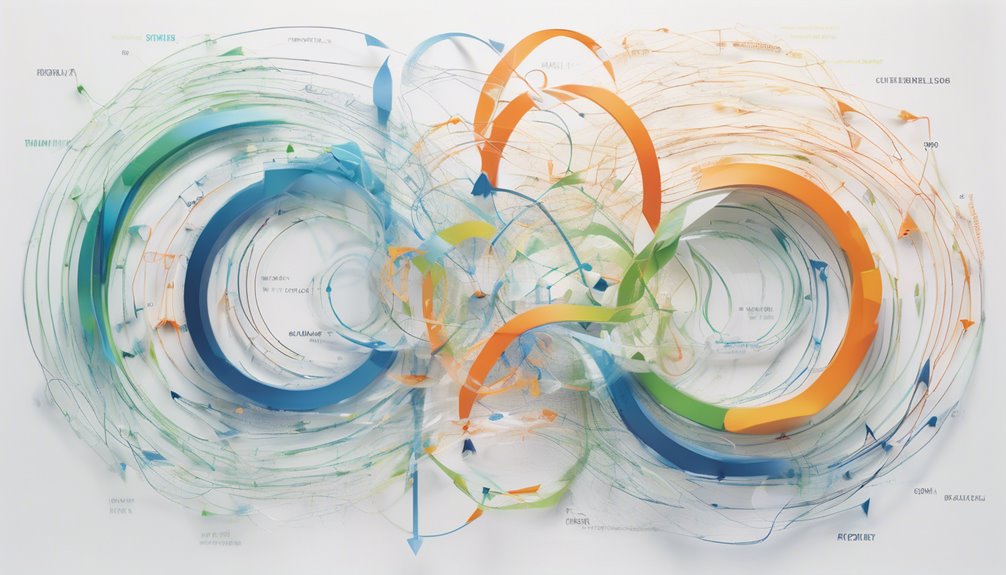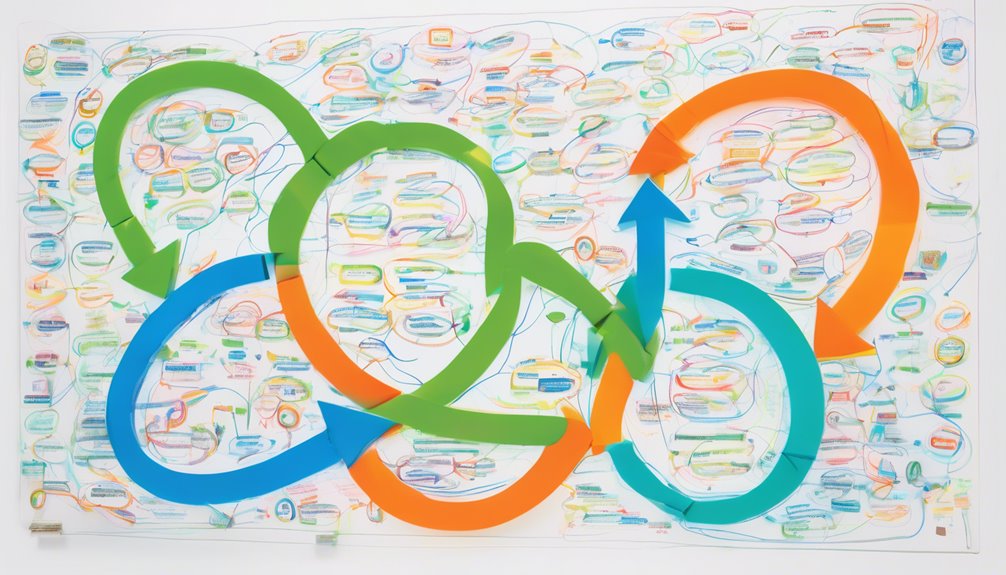A causal loop diagram is a powerful tool that helps you visualize the interconnectedness of variables in a system. It can clarify how changes in one aspect can ripple through to affect others. Understanding this can be crucial for effective decision-making. But what exactly are the key components that make up these diagrams, and how can they be applied across different fields? Let's explore.
What Is a Causal Loop Diagram?

A causal loop diagram is a visual tool that helps you understand the relationships between different variables in a system. By illustrating how these variables interact, you can identify feedback loops—both positive and negative—that affect outcomes.
This diagram simplifies complex systems, enabling you to grasp how changes in one element can influence others. It's particularly useful in fields like business, ecology, and social sciences, where understanding dynamics is crucial.
When you create a causal loop diagram, you'll see how your decisions can lead to various consequences. This insight empowers you to anticipate potential issues and adjust strategies accordingly.
Ultimately, a causal loop diagram serves as a roadmap for navigating intricate systems effectively.
Key Components of Causal Loop Diagrams
Understanding the key components of causal loop diagrams enhances your ability to analyze complex systems effectively. The primary elements include variables, which represent different factors that influence the system.
Arrows connect these variables, indicating the direction of influence. A positive link shows that an increase in one variable leads to an increase in another, while a negative link indicates that an increase in one variable results in a decrease in another.
Additionally, you'll encounter feedback loops, which can be reinforcing or balancing, further shaping the system's behavior. By grasping these components, you can better visualize interactions and anticipate changes within the system, leading to more informed decision-making and problem-solving strategies.
Understanding Feedback Loops

Feedback loops play a crucial role in shaping the dynamics of a system, as they illustrate how changes in one variable can influence others over time.
You'll find that these loops can be either reinforcing or balancing. In a reinforcing loop, an initial change leads to further changes in the same direction, creating a cycle of growth or decline.
On the other hand, a balancing loop seeks to stabilize the system by countering changes, helping maintain equilibrium.
Understanding these loops helps you identify potential outcomes and anticipate unintended consequences.
Types of Causal Relationships
When analyzing systems, recognizing the types of causal relationships is essential, as they determine how variables interact and influence each other.
There are two primary types: positive and negative relationships. In a positive relationship, when one variable increases, the other does too. For instance, if you invest more time in studying, your grades likely improve.
Conversely, in a negative relationship, an increase in one variable leads to a decrease in another. For example, if you spend more time on social media, your study time may drop, negatively impacting your grades.
Understanding these interactions helps you predict outcomes and make informed decisions. By identifying these relationships, you can better navigate complex systems and improve your problem-solving skills.
Creating a Causal Loop Diagram

Recognizing the types of causal relationships lays the groundwork for creating a Causal Loop Diagram. Start by identifying the key variables in your system, such as inputs, outputs, and feedback loops.
Once you've pinpointed these elements, determine how they influence one another—are they reinforcing or balancing? Use arrows to represent these relationships, clearly indicating the direction of influence. Label each arrow with a "+" for positive relationships and a "-" for negative ones.
As you draw the diagram, ensure it reflects the dynamic interactions within the system. Finally, review your diagram for clarity and accuracy, making adjustments as needed.
This visual representation will help you understand the complexities of the system and facilitate discussions with others.
Applications in Business
Causal Loop Diagrams are invaluable tools in business, as they help you visualize complex systems and identify the interdependencies among various factors. By mapping out feedback loops, you can better understand how changes in one area affect others, enabling you to make informed decisions.
For instance, if you're managing supply chain dynamics, a Causal Loop Diagram can reveal how inventory levels influence production rates and customer satisfaction. This insight can help you adjust strategies to optimize performance.
Additionally, you can use these diagrams for strategic planning, risk assessment, and process improvement. Overall, incorporating Causal Loop Diagrams into your business practices allows you to anticipate challenges and seize opportunities, leading to more effective management and sustainable growth.
Applications in Environmental Studies

Causal Loop Diagrams also hold significant value in environmental studies. By visualizing complex interactions between various environmental factors, you can better understand how changes impact ecosystems.
For instance, you can map out relationships between pollution, biodiversity, and climate change. This helps identify leverage points where interventions might be most effective.
When you analyze these diagrams, you'll spot feedback loops that can either exacerbate or mitigate environmental issues. They're particularly useful for modeling scenarios like deforestation or water resource management.
Applications in Social Sciences
While understanding societal dynamics can be complex, Causal Loop Diagrams offer a powerful tool for visualizing relationships among social factors. You can use these diagrams to map out how variables like education, income, and health interact with one another.
By illustrating feedback loops, you'll see how changes in one area can ripple through society, affecting everything from crime rates to community engagement. They help you identify leverage points, enabling you to focus on the most impactful areas for intervention.
Whether you're examining policy impacts or community development, Causal Loop Diagrams provide a clear framework for decision-making. This clarity can enhance discussions among stakeholders, making it easier to align on strategies and goals.
Benefits of Using Causal Loop Diagrams

Using Causal Loop Diagrams brings several benefits that enhance your understanding of complex systems.
First, they simplify complex interactions, making it easier for you to visualize relationships between variables. This clarity helps identify feedback loops, which are crucial for understanding system behavior over time.
Second, you can engage stakeholders more effectively, as these diagrams facilitate discussions and foster collaborative problem-solving.
Third, they encourage you to think critically about system dynamics, leading to better decision-making.
Finally, Causal Loop Diagrams are versatile tools that can be applied across various fields, from social sciences to engineering.
Conclusion
In summary, causal loop diagrams are powerful tools for visualizing complex relationships within systems. By understanding feedback loops and the types of causal relationships, you can create effective diagrams that reveal interdependencies. Whether you're in business, environmental studies, or social sciences, these diagrams can enhance your decision-making and strategic planning. Embracing this approach not only clarifies your understanding but also empowers you to anticipate potential outcomes and make informed choices.

